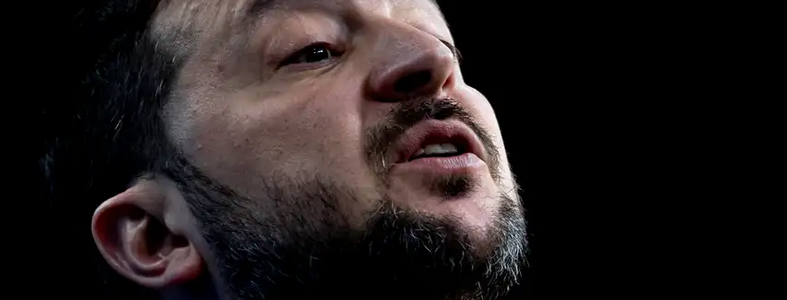
The US wants to trade further military and financial aid to Ukraine for access to the country’s vast rare earth reserves. But some might already be under Russian control, and the EU is moving in for its share, too.
US President Donald Trump has placed new conditions on further financial and military aid to Ukraine.
On Monday, he told reporters that Washington would only continue aiding Ukraine in warding off Russian aggression in exchange for rare earth minerals.
Kyiv had already indicated it would be willing to trade access to these valuable natural resources for Western support. In fact, it was one of the points Ukrainian President Volodymyr Zelenskyy had outlined in the “victory plan” that he presented late last year when it was still unclear who would occupy the White House in 2025.
At the time, Zelenskyy had been in talks with Trump, and had promised any country willing to support Kyiv that there would be “returns on investments” made in his country. While presenting his plan, he also mentioned Ukraine’s rich natural resources, which amounted to “trillions of US dollars’ worth of vitally important metals.”
Indispensable in modern industries
Rare earth minerals are needed to produce many modern devices, such as smartphones, electric vehicles, and other high-tech products. They are indispensable in weapons manufacturing and the aerospace industry.
China currently controls the lion’s share of industrially used rare earth minerals worldwide. According to a recent report
by the World Economic Forum, this covers about 40% of the European Union’s (EU) needs for these resources. Other key providers include Australia, South Africa, Canada and Brazil.
To reduce their dependency on China, the US and EU have been working together for years on expanding and increasing the production of vital resources in other countries. These metals, include, above all, uranium, titanium, lithium, graphite, nickel, and aluminum.
Last year, a study
by the NATO Energy Security Center of Excellence found that the market for critical minerals “has doubled to over $320 billion [€308.7 billion] in the last five years and is foreseen to double again in the next five.”
Enormous wealth of critical minerals
The NATO experts also noted that “the strategic importance of Ukraine’s critical materials cannot be overstated,” arguing that the country could become a key supplier of rare earth minerals, including titanium, lithium, beryllium, manganese, gallium, uranium, zirconium, graphite, apatite, fluorite and nickel. These vast reserves could “significantly contribute to the global supply chain for many, if not all,” prominent industries.
Ukraine’s titanium reserves are thought to be Europe’s largest, making some 7% of global reserves. It’s one of the few countries mining titanium, which is a key resource for the aerospace, medical, automotive and marine industries, for example.
Estimated at around 500,000 tons, Ukraine also holds some of Europe’s largest known lithium reserves. This material is critical for producing batteries, ceramics, and glass.
Ukraine is also the world’s fifth-largest producer of gallium, which is used for producing semiconductors and light-emitting diodes (LEDs). Finally, Ukraine is a critical supplier of neon gas, required for producing semiconductors.
The World Economic Forum report further found that the European Commission had identified Ukraine as a potential supplier for over 20 critical raw materials. The body recommended that Europe continue to encourage Ukraine to export these materials, and concluded that Ukraine’s accession to the EU could strengthen the European economy.
Ukraine an important part of the EU resource strategy
Kyiv seems to be well aware of its key position as a potential global supplier of critical minerals needed for key industries. At a conference on strategic resources, the former Ukrainian infrastructure minister an co-founder of the investment think tank We Build Ukraine, Oleksandr Kubrakov, noted that, “we own crucial resources, we are strategically well-positioned within the EU context, our logistical infrastructure is well-developed and we are highly competent in discovering and exploiting resources.”
But critics say that optimal conditions for mining critical minerals would require governmental oversight, a stable regulatory framework, an economically tolerable tax policy, and investments. It’s uncertain if the US, should it gain access to some of Ukraine’s critical natural resources, would even be able to initiate such structural change.
Meanwhile, authorities in Kyiv are already reporting on first steps and concrete plans: “We are currently making data on these minerals public and have worked out many regulatory and legal measures,” Olena Kramarenko, Ukraine’s deputy minister of environmental protection said.
She added that the strategic goal was to “integrate Ukraine into the EU’s resource strategy.”
Some reserves occupied by Russia
The largest hurdle to exploiting rare earth minerals in Ukraine remains Russia’s war of aggression. There are no reliable numbers available of just how many rare mineral reserves are under Russian control, or dangerously near front lines.
Ukrainian experts told DW they believe that Russia could be trying to gain control over at least two lithium reserves. Of the four known across Ukraine, only two are sure to be under Ukrainian control.
The territories of Zaporizhzhia and Donetsk, where the other two reserves are located, are currently under Russian occupation.
https://www.dw.com/en/ukraines-rare-earths-are-key-to-its-bargaining-power/a-71531476